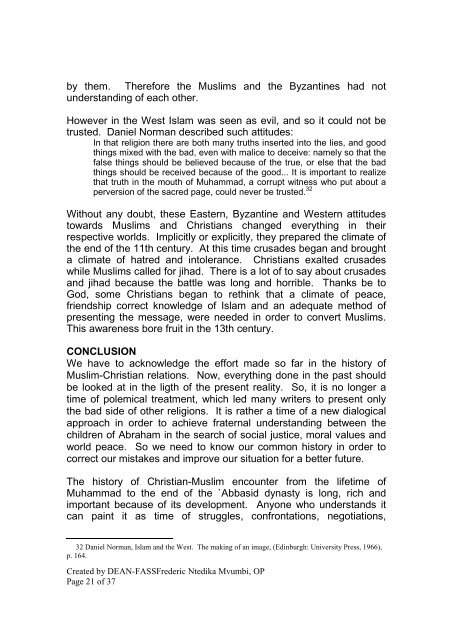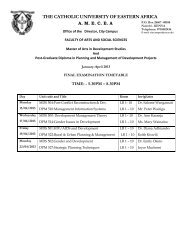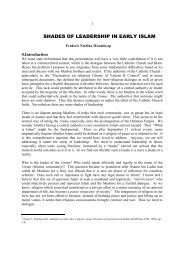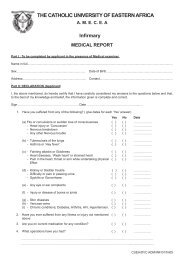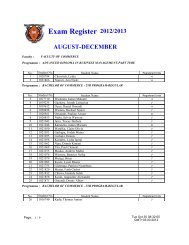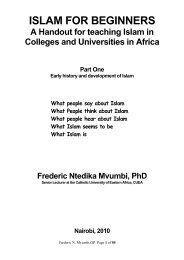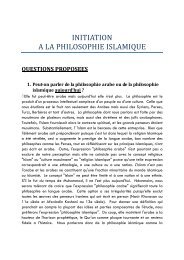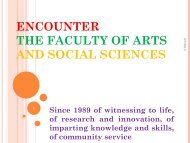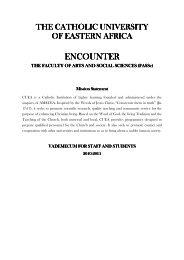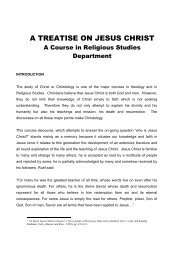PRINCIPLES FOR INTERRELIGIOUS DIALOGUE.pdf - CUEA
PRINCIPLES FOR INTERRELIGIOUS DIALOGUE.pdf - CUEA
PRINCIPLES FOR INTERRELIGIOUS DIALOGUE.pdf - CUEA
You also want an ePaper? Increase the reach of your titles
YUMPU automatically turns print PDFs into web optimized ePapers that Google loves.
y them. Therefore the Muslims and the Byzantines had not<br />
understanding of each other.<br />
However in the West Islam was seen as evil, and so it could not be<br />
trusted. Daniel Norman described such attitudes:<br />
In that religion there are both many truths inserted into the lies, and good<br />
things mixed with the bad, even with malice to deceive: namely so that the<br />
false things should be believed because of the true, or else that the bad<br />
things should be received because of the good... It is important to realize<br />
that truth in the mouth of Muhammad, a corrupt witness who put about a<br />
perversion of the sacred page, could never be trusted. 32<br />
Without any doubt, these Eastern, Byzantine and Western attitudes<br />
towards Muslims and Christians changed everything in their<br />
respective worlds. Implicitly or explicitly, they prepared the climate of<br />
the end of the 11th century. At this time crusades began and brought<br />
a climate of hatred and intolerance. Christians exalted crusades<br />
while Muslims called for jihad. There is a lot of to say about crusades<br />
and jihad because the battle was long and horrible. Thanks be to<br />
God, some Christians began to rethink that a climate of peace,<br />
friendship correct knowledge of Islam and an adequate method of<br />
presenting the message, were needed in order to convert Muslims.<br />
This awareness bore fruit in the 13th century.<br />
CONCLUSION<br />
We have to acknowledge the effort made so far in the history of<br />
Muslim-Christian relations. Now, everything done in the past should<br />
be looked at in the ligth of the present reality. So, it is no longer a<br />
time of polemical treatment, which led many writers to present only<br />
the bad side of other religions. It is rather a time of a new dialogical<br />
approach in order to achieve fraternal understanding between the<br />
children of Abraham in the search of social justice, moral values and<br />
world peace. So we need to know our common history in order to<br />
correct our mistakes and improve our situation for a better future.<br />
The history of Christian-Muslim encounter from the lifetime of<br />
Muhammad to the end of the `Abbasid dynasty is long, rich and<br />
important because of its development. Anyone who understands it<br />
can paint it as time of struggles, confrontations, negotiations,<br />
32 Daniel Norman, Islam and the West. The making of an image, (Edinburgh: University Press, 1966),<br />
p. 164.<br />
Created by DEAN-FASSFrederic Ntedika Mvumbi, OP<br />
Page 21 of 37


